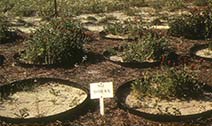Boron deficiency in sorghum

Sorghum is grown for both food and forage in semi-arid and subtropical regions around the world. Fertilizing sorghum with a minimum amount of boron is crucial role for:
- Helping sugars and nutrients move from leaves to reproduction systems
- Supporting the development of plant organs
- Increasing pollination
- Increasing seed development
- Strengthening cell walls
Under normal growing conditions, boron can maximize forage yields. But, when you have high salinity soils, you may also have high concentrations of boron.
Boron deficiency symptoms include white streaks on the young leaves, narrow gray leaves with transparent stripes, and ear sterility. In addition, sorghum seed heads may not be fully filled.
Reducing boron deficiency
A recent study has shown that using 5 mg L-1 of boron under higher salinity levels could significantly increase forage yields in terms of green and dry matter weights.* In addition, other research indicates increased yield for rain-fed crops that receive balanced fertilization.**
Before applying boron added fertilizers, take soil tests to know nutrient levels then, follow up with sorghum tissue samples in the growing season to verify root uptake by the plants.
* Alkhamisi, Saif, et al. (2017) Influence of Boron on Sorghum (Sorghum Bicolor L.) Forage Yield under Different Water Salinity Levels. Int J Contemp Appl Res, 4:8. 50-61.
** K. L. Sahrawat, et al. (2008) Sulfur, Boron, and Zinc Fertilization Effects on Grain and Straw Quality of Maize and Sorghum Grown in Semi-Arid Tropical Region of India, J Plant, 31:9, 1578-1584.